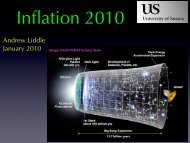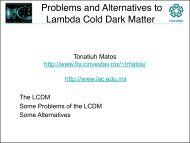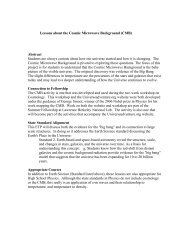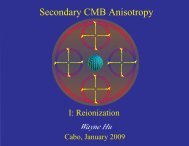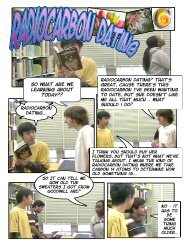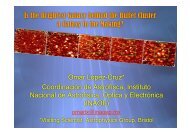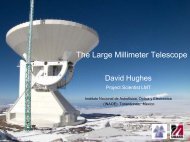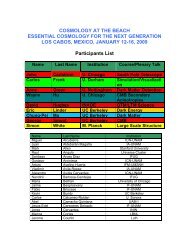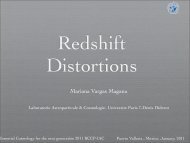CMB Lensing reconstruction with the South Pole Telescope
CMB Lensing reconstruction with the South Pole Telescope
CMB Lensing reconstruction with the South Pole Telescope
Create successful ePaper yourself
Turn your PDF publications into a flip-book with our unique Google optimized e-Paper software.
<strong>CMB</strong> <strong>Lensing</strong><br />
<strong>reconstruction</strong> <strong>with</strong> <strong>the</strong><br />
<strong>South</strong> <strong>Pole</strong> <strong>Telescope</strong><br />
A. van Engelen, G. Holder, SPT collaboration
SPT<br />
• 10 m dish - 1’ FWHM beam<br />
• Observes at 3 frequencies: 90,<br />
150, 220 GHz<br />
• ~1000 detectors<br />
SPT survey<br />
• Survey Depth is 18 uK-arcmin<br />
• 2500 sq deg by ~end of 2011; ~1400<br />
right now; we use ~500 sq deg from<br />
2008 and to 2009 survey surveysdepth.<br />
• So far have mapped<br />
~700 square degrees<br />
• Full survey will be<br />
These properties make it<br />
~1500-2000 square<br />
ideal for studying lensing!<br />
degrees.<br />
δθrms ~ (concentrate 2.4 ‘ on<br />
Sample-variance higher-latitude dominated well /<br />
into <strong>the</strong> more-negative-dec<br />
damping tail<br />
regions)<br />
The Survey<br />
Funded<br />
by NSF<br />
The <strong>South</strong> <strong>Pole</strong> <strong>Telescope</strong> (SPT)<br />
Millimeter Wavelength Tele<br />
good enough to use at sub<br />
• 10 meter telescope (1’ FWHM<br />
GHz)<br />
• Off-axis Gregorian optics desi<br />
• 20 microns RMS surface accur<br />
• 1 arc-second pointing<br />
• Fast scanning (up to 4 deg/sec<br />
SZ receiver:<br />
• 1 sq. deg FOV<br />
• ~960 background limited pixel<br />
• Observe in 3+ bands between 9<br />
simultaneously <strong>with</strong> a modular<br />
T. Crawford, UChicago/KICP, <strong>South</strong> <strong>Pole</strong> <strong>Telescope</strong> Science, Playa del Carmen, January 12, 20
•<br />
•<br />
Map for primary <strong>CMB</strong> science (1 of 4)<br />
Led by Ryan Keisler - see his talk<br />
(following this one)<br />
Filtered for 500 < l < 3000<br />
•<br />
•<br />
~500 sq deg at 18 uK’<br />
150 GHz only
ly<br />
l<strong>CMB</strong>2<br />
L<br />
<strong>Lensing</strong><br />
• Non-gaussian mode coupling for l1 = −l2 :<br />
l<strong>CMB</strong>1<br />
lx<br />
• We extract ϕ by taking an average<br />
over <strong>CMB</strong> multipoles separated by<br />
a distance L<br />
•<br />
We use <strong>the</strong> standard Hu quadratic<br />
estimator.
Quadratic Estimator (Hu 2002)<br />
• We adopt <strong>the</strong> standard Optimal Quadratic<br />
Estimator<br />
• Make a filtered gradient map (filtered)<br />
• Make a high-pass filtered map<br />
• Multiply <strong>the</strong>m in real space<br />
• Take <strong>the</strong> divergence<br />
• Renormalize to ensure<br />
<strong>CMB</strong> = ϕ(L), to first order in ϕ<br />
• Power in this map probes <strong>CMB</strong> trispectrum;<br />
ϕ est ~ T 2 ; |ϕ est | 2 ~ T 4<br />
• Filters are tuned to maximize S/N;<br />
downweight noisy modes<br />
•<br />
assumed <strong>CMB</strong> spectra<br />
“gradient” filter<br />
“high-pass” filter
SPT noise power<br />
• Due to SPT azimuthal scan strategy, noise is lowest in lx-direction in Fourier space<br />
• We cut at 1200 < l < 4000, as well as a vertical strip <strong>with</strong> |lx| < 1000<br />
• This makes <strong>the</strong> recovered lensing field anisotropic
•<br />
<strong>reconstruction</strong> is ~4x noisier<br />
in Ly than Lx direction<br />
SPT 2d noise<br />
• Inverse-variance weight when<br />
computing power spectrum<br />
• gives overall noise bias<br />
Azimuthal mean
Mitigating <strong>the</strong> noise bias<br />
• Noise bias comes from gaussian power (unconnected four-point function) in<br />
map<br />
• Das et al (2011) run simulations <strong>with</strong> measured map amplitude (and random phases) through pipeline<br />
• The power found in SPT maps agrees well <strong>with</strong> that in our simulations (up to a<br />
measurable, constant factor); we can subtract<br />
• SPT calibration uncertainty (5% in power) still feeds into lensing signal from<br />
off-diagonal couplint
Ano<strong>the</strong>r way to mitigate <strong>the</strong> noise bias<br />
• Can use disjoint pieces of temperature Fourier space<br />
(from same field), constructing two Φ maps; <strong>the</strong>n<br />
compute cross-power<br />
•<br />
•<br />
Result will not contain bias from Gaussian signal (Hu<br />
2001, Sherwin & Das 2010)<br />
S/N hit ~ 3/8<br />
lmin<br />
lsplit<br />
lmax<br />
S/N<br />
(256 sq deg)<br />
lsplit
Apodization effects<br />
• Apodization leads to mode coupling<br />
• We run estimator initially neglecting<br />
this, <strong>the</strong>n deal <strong>with</strong> effects<br />
• Additive large-scale signature. Peaks<br />
at low L; factor of 5 brighter than <strong>the</strong><br />
deflection signal<br />
• Monte Carlo it & subtract<br />
one raw <strong>reconstruction</strong> apod signature difference<br />
data window<br />
10°<br />
1.00<br />
0.833<br />
0.667<br />
0.500<br />
0.333<br />
0.167<br />
0.00
•<br />
•<br />
Spread from one point<br />
source<br />
1°<br />
in out<br />
Low SPT noise allows<br />
us to detect point<br />
sources down to a 5σ<br />
depth of ~5 mJy at 150<br />
GHz<br />
Point sources Vieira et al 2009<br />
220 GHz flux<br />
SMGs<br />
150 GHz flux<br />
Radio galaxies
•<br />
Cut at 65 mJy<br />
<strong>CMB</strong> + 18 uK’<br />
whitenoise +<br />
Poisson field ,+<br />
<strong>CMB</strong> + 18 uK’<br />
whitenoise +<br />
Gaussian field<br />
<strong>with</strong> same<br />
power<br />
Top: gradient<br />
estimator;<br />
bottom: curl<br />
estimator<br />
Poisson point sources<br />
pix<br />
auto
•<br />
Cut at 41 mJy<br />
<strong>CMB</strong> + 18 uK’<br />
whitenoise +<br />
Poisson field ,+<br />
<strong>CMB</strong> + 18 uK’<br />
whitenoise +<br />
Gaussian field<br />
<strong>with</strong> same<br />
power<br />
Top: gradient<br />
estimator;<br />
bottom: curl<br />
estimator<br />
Poisson point sources<br />
pix<br />
auto
•<br />
Cut at 26 mJy<br />
<strong>CMB</strong> + 18 uK’<br />
whitenoise +<br />
Poisson field ,+<br />
<strong>CMB</strong> + 18 uK’<br />
whitenoise +<br />
Gaussian field<br />
<strong>with</strong> same<br />
power<br />
Top: gradient<br />
estimator;<br />
bottom: curl<br />
estimator<br />
Poisson point sources<br />
pix<br />
auto
•<br />
Cut at 16 mJy<br />
<strong>CMB</strong> + 18 uK’<br />
whitenoise +<br />
Poisson field ,+<br />
<strong>CMB</strong> + 18 uK’<br />
whitenoise +<br />
Gaussian field<br />
<strong>with</strong> same<br />
power<br />
Top: gradient<br />
estimator;<br />
bottom: curl<br />
estimator<br />
Poisson point sources<br />
pix<br />
auto
•<br />
SZ map<br />
(Sehgal et al 2009)<br />
Unmodified<br />
tSZ<br />
Clusters pop out in <strong>reconstruction</strong>:<br />
Deflection<br />
auto
• tSZ power in sims<br />
is ~double <strong>the</strong><br />
measured value<br />
• Knock down power<br />
in Sehgal sims<br />
tSZ<br />
• SZ bias vs. masking<br />
level: Hall et al 2010<br />
auto
Signal > Noise<br />
at L < 200<br />
Results: mapping structure at z ~ 2<br />
Planck-like noise<br />
(27 uK ‘, 7’ beam)<br />
SPT-like noise<br />
(18 uK ‘, 1’ beam)<br />
No-noise limit<br />
(point sources only)<br />
10 o<br />
20 o<br />
• High-res., low-noise<br />
experiments like SPT and<br />
ACT can map individual<br />
modes on large scales <strong>with</strong><br />
S/N > 1<br />
• <strong>Lensing</strong> convergence map,<br />
filtered on degree scales;<br />
real map of real structure
<strong>Lensing</strong> power spectra<br />
• Obtain gaussian bias from simulations which closely match <strong>the</strong><br />
SPT observations;<br />
• Obtain lensing transfer functions from diff. between<br />
observations of lensed and unlensed <strong>CMB</strong><br />
PRELIMINARY<br />
Cyan shows combined fields<br />
PRELIMINARY
•<br />
•<br />
Curl null test (Cooray et al 2005)<br />
In <strong>reconstruction</strong>, replace<br />
divergence of gradient <strong>with</strong><br />
“curl” of gradient<br />
∂xgx + ∂ygy → ∂ygx − ∂xgy<br />
No signal detected (after<br />
subtracting noise bias similar<br />
to gradient case)
Various datasets
•<br />
•<br />
•<br />
•<br />
Summary & Outlook<br />
Detection of lensing power spectrum from SPT is<br />
forthcoming, at very high significance based on ~500 sq deg<br />
Foregrounds not a huge problem<br />
Full SPT temperature survey will be 2500 sq deg at 18 uK’<br />
depth - plus maps at 90 and 220 GHz<br />
SPTpol upcoming
Very quick overview of some SPT science (relevant for lensing)<br />
Galaxy cluster survey<br />
• Staniszewski et al 2009: first clusters<br />
detected in SZ<br />
• Vanderlinde et al 2010:<br />
Microwave point sources<br />
Vieira et al 2009<br />
Microwave power spectra at high<br />
multipole: secondaries<br />
Lueker et al 2010, Hall et atl 2010<br />
Shirokoff et al 2011<br />
Hall et al 2010
• polarization<br />
upgrade coming<br />
to SPT at end of<br />
2011 or so<br />
•<br />
SPT-pol lensing<br />
band shows<br />
+-0.5 eV in<br />
mn
<strong>CMB</strong> Power spectrum science<br />
• Detection of secondary<br />
anisotropy and measurement of<br />
low tSZ power (Lueker et al<br />
2010);<br />
Detection of clustered dusty<br />
sources (Hall et al 2010);<br />
tighter constraints <strong>with</strong> more<br />
sky(Shirokoff et al 2010)<br />
• Next result will be power<br />
spectra covering primary <strong>CMB</strong><br />
500 < L < 3000<br />
• See Ryan Keisler’s talk, next<br />
• We use <strong>the</strong>se fields for <strong>the</strong><br />
lensing analysis<br />
Hall et al 2010<br />
Simulation similar to upcoming primary <strong>CMB</strong> paper<br />
(Keisler et al)



